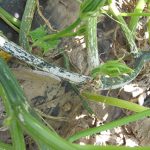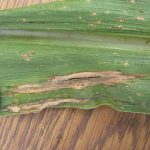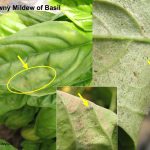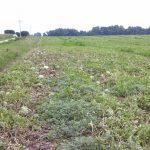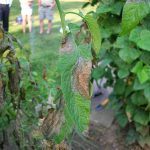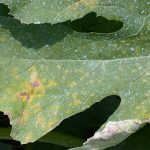I have observed this disease in several pumpkin fields this year. It is not clear to me why this disease seems to be more widespread compared to recent seasons. However, it makes sense to review Plectosporium blight here. Plectosporium blight is usually not a serious disease. The occurrence of this disease is usually sporadic. However, when[Read More…]
The relatively cool weather Indiana has experienced this summer may be responsible for more observations of northern corn leaf blight (NCLB) on sweet corn than normal. The primary symptom is the cigar shaped lesion that ranges from 1 to 7 inches in length (see Figure 1). The lesions may range from tan to gray in color.[Read More…]
When used as a verb, to rogue means to get rid of items that don’t conform to a certain standard. In plant pathology, the word rogue is used to describe a technique whereby diseased plants are removed or rogued to slow the spread of disease. I’d like to describe the practice as it might be used[Read More…]
Downy mildew has been confirmed on jack-o-lantern pumpkins in Daviess and Jasper Counties and on acorn squash in LaPorte County. These are the first confirmed reports of this disease on Cucurbita pepo in Indiana in the 2015 season. There are unconfirmed (but reliable) reports of downy mildew on pumpkins in Parke, Washington, and White Counties. This disease has[Read More…]
This disease has been observed in northern Indiana on basil sold as a fresh herb. The fungus that causes downy mildew of basil does not overwinter in Indiana, but must blow in from the south. The fungus that causes downy mildew of basil is not the same fungus that causes downy mildew of cucurbits or[Read More…]
On July 22, I announced that downy mildew had been observed on watermelon in Knox County in southwestern Indiana. This article in the Vegetable Crop Hotline issue 603, https://ag.purdue.edu/hla/Extension/VegCropsHotline/Pages/Latest-Articles.aspx?article=118, describes the outbreak and management options. Downy mildew has now been reported on cucumber and cantaloupe in Knox and cucumber in La Porte County Indiana and pumpkin in Jasper County.[Read More…]
Protecting vegetable crops from foliar disease involves many factors. Crop rotation and fall tillage will help to lessen disease severity. Choosing a resistant or partially resistant variety can lower the amount of disease. Purchasing seed that has been tested for seed borne disease is also an important factor. Most growers, however, find it is also[Read More…]
Tomato growers who utilize high tunnels to reach early markets often find that there are few economic alternatives to tomato. Therefore, many growers grow tomatoes after tomatoes instead of rotating to a different crop. The repeated cropping of tomato in the same area can lead to disease problems such as Fusarium crown rot and white[Read More…]
Late blight has been reported on potatoes and tomatoes in LaGrange County.Potato and tomato growers in northern Indiana should follow the management recommendations listed below and in the Midwest Vegetable Production Guide for Commercial Growers 2015 (ID-56). Late blight thrives under cool, wet conditions. The disease can easily spread from plant to plant. Under ideal[Read More…]
On July 22, I announced that downy mildew had been observed on watermelon in Knox County in southwestern Indiana. This article https://ag.purdue.edu/arp/swpap/VeggieDiseasesBlog/Lists/Posts/Post.aspx?ID=48 describes the outbreak and management options. Below, I will discuss the whereabouts of additional downy mildew outbreaks on cucurbits. Downy mildew has now been reported on cucumber in Knox and La Porte County Indiana.[Read More…]

